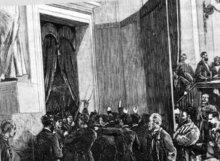Coup d'état of Pavía
 Illustration of Pavia's troops entering the Congress of Deputies | |
| Native name | Golpe de Estado de Pavía |
|---|---|
| Date | January 3, 1874 |
| Location | Congress of Deputies,Madrid,Spain |
| Coordinates | 40°24′57″N3°41′48″W/ 40.41583°N 3.69667°W |
| Type | Coup d'état |
TheCoup d'état of Pavía(Spanish:Golpe de Estado de Pavía), or more simplyPavía's Coup,was a militarycoup d'étatinitiated by GeneralManuel Pavía y Rodríguez de Alburquerqueon January 3, 1874 during theFirst Spanish Republicthat transitioned the young republic from a democratic government to an authoritarian regime.
Background[edit]
The Spanish Republic had been formed in February 1873 during the turbulent period ofSpanish historyknown as theSexenio Democrático.The Spanish parliament, theCortes Generales,had been fractured throughout 1873 and consensus between the moderates, centrists, and intransigents could not be reached.[1]: 381–382 National unity was of particular concern to many members of Cortes as there were two simultaneous revolts in Spain: the conservativeCarlist uprisingin northern Spain and the socialistCantonal rebellionin southern Spain.Emilio Castelar,a political moderate, had beenPresident of the Executive Powersince September 7, 1873 and had suspended the Cortes on September 20 in order to take more effective control of the military.[2]: 317 With worsening situations on both fronts, Castelar called for the Cortes to reconvene on January 2, 1874, in an effort to seek unlimited powers.
Coup[edit]
General Pavia, a supporter of President Castelar, positioned his troops across from theCongress of DeputiesinMadridon January 2 in anticipation of the deputies reconvening. Shortly after midnight, in the early morning of January 3, avote of confidencetook place and Castelar's government lost with 100 votes of support against 120 votes opposed.[2]: 322 A new vote was then held to elect a new President of the Executive and when it appeared that the radicals in the Cortes (the "intransigents" ) were preparing to elect the avowed republicanEduardo Palanca Asensi,Pavia ordered his troops to surround the Cortes and request the session be dissolved. Former presidentNicolás Salmerón y Alonsowas presiding over the vote and remained in the Cortes with other deputies until Pavia's forces entered by force.[2]: 323 At 6:55am on January 3, the deputies were vacated from the building without any casualties. Pavia offered the presidency to Castelar who refused due to the despotic nature of the morning's events.[1]: 402 Instead, Pavia recruited former prime ministerFrancisco Serranowho had been in exile in France following a previous failed coup attempt in April 1873. Serrano was markedly anti-republican and did not support the Cortes during the first republic, and he officially dissolved the Cortes on January 8, 1874.[2]: 329
Aftermath[edit]
Pavia's coup on January 3 effectively marked the end of the Spanish Republic although it would continue to exist in-name until December 29, 1874 when the Bourbon monarchy was peacefullyrestored in Spain.[3]In the intervening time, Serrano operated ade factomilitary dictatorship during which time opposition was suppressed.
References[edit]
- ^abVilches, Jorge (2001).Progreso y Libertad: El Partido Progresista en la Revolución Liberal Española(in Spanish). Madrid, Spain: Alianza Editorial.ISBN84-206-6768-4.
- ^abcdBrandt, Joseph A. (1933).Toward the New Spain.Chicago, IL: The University of Chicago Press.
- ^"Manuel Pavía y Rodríguez de Alburquerque".Britannica.The Editors of Encyclopaedia Britannica.Retrieved28 August2022.
